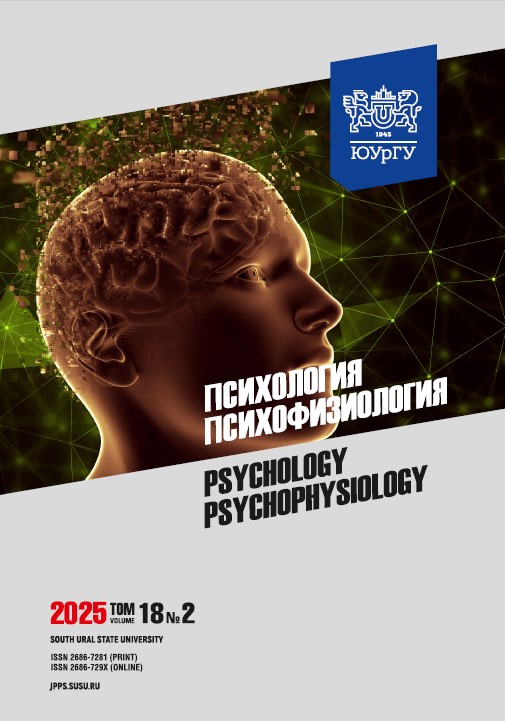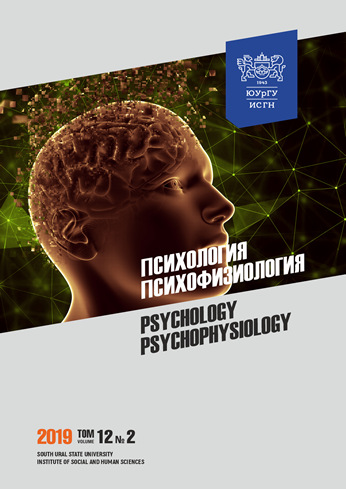Hierarchy of motivational-semantic formations in late adolescence across educational programs
Abstract
Introduction: The developmental tasks inherent to early adulthood – marked by the transition to autonomous life decisions – are significantly compounded by sociocultural complexities. Thus, an emotionally demanding decision-making process transforms into a difficult choice between countless life trajectories. Early identification of professional predispositions and domain-specific motivational and semantic frameworks may facilitate adaptive resolution of these developmental challenges. Aims: This paper aims to identify how educational environments shape distinct patterns of motivational-semantic development in late adolescence across four academic programs (general education, natural sciences, humanities, and technical programs) in secondary schools, gymnasiums, and lyceums. Hypothesis: Meaning formation processes during late adolescence demonstrate domain-dependent patterns across academic programs. Materials and methods: The study sample comprised 290 students aged 15–18 years. Empirical data were collected using the Gordeeva’s Academic Motivation Scale (school/college version) and the Kotlyakov’s System of Life Meanings. Group differences in semantic formation types and properties were analyzed using the Kruskal–Wallis test, post-hoc Mann–Whitney tests with Bonferroni correction, and descriptive statistics. Results: Statistically significant differences were observed in semantic motives across academic groups. Distinct hierarchical patterns of meaning formation emerged among high school students from different educational programs. Conclusion: Specialized curricula shape unique semantic formation patterns, serving as developmental resources. These processes organize life purpose through academic motivation hierarchies while evolving differently across academic groups.
Downloads
References
2. Gaevskaya L.G. The Analysis of Sense-Making Activity and Its Structural Components. Izvestiya Irkutskogo gosudarstvennogo universiteta. Seriya Psikhologiya = Bulletin of Irkutsk State University. Series Psychology. 2022;42:21–33. (in Russ.). DOI: 10.26516/2304-1226.2022.42.21.
3. Asmolov A.G., Bratus B.S., B.V. Zejgarnik et al. On some prospects for the study of semantic formations of personality. Voprosy psihologii. 1979;3:35–45. (in Russ.).
4. Karpinskii K.V. Psikhologiya smyslozhiznennogo krizisa [The psychology of the meaning of life crisis]. Grodno. GrSU Publ. 2019:624. (in Russ.).
5. Kolmogorova L.S., Holodkova O.G. Stanovlenie tsennostno-smyslovoi sfery lichnosti v yunosheskom vozraste [The formation of the value-semantic sphere of personality in adolescence]. Barnaul. AltSPU Publ. 2023:242. (in Russ.). DOI: 10.37386/978-5-907487-48-2.
6. Vaingankar J.A., Subramaniam M., Seow E. et al. Youth Positive Mental Health Concepts and Definitions: A Systematic Review and Qualitative Synthesis. International Journal of Environmental Research and Public Health. 2022;19:11506. DOI: 10.3390/ijerph191811506.
7. Steger M.F. Making Meaning in Life. Psychological Inquiry. 2012;23(4):381–385. DOI: 10.1080/1047840X.2012.720832/
8. Schnell T. Individual differences in meaning-making: Considering the variety of sources of meaning, their density and diversity. Personality and Individual Differences. 2011;51(5):667–673. DOI: 10.1016/j.paid.2011.06.006.
9. Heintzelman S.J., King L.A. Meaning in life and intuition. Journal of Personality and Social Psychology. 2016;110(3):477–492. DOI: 10.1037/pspp0000062/
10. Han J., Wang Y., Qian J., Shi M. Delving into the role of creativity on meaning in life: A multiple mediation model. Heliyon. 2023;9(6):e16566. DOI: 10.1016/j.heliyon.2023.e16566/
11. Czyzowska N. Identity ˙Processing Style and Meaning in Life among Emerging Adults: Mediational Role of Commitment. International Journal of Environmental Research and Public Health. 2022;19(11):6585. DOI: 10.3390/ijerph19116585/
12. Rostovceva M.V., Popov V.V., Dulinec T.G., Smirnova L.E., Avdeeva T.G. Psychological well-being and existential fulfillment in late adolescence. Psihologiya i Psihotekhnika = Psychology and psychotechnics. 2022;3:42–54. (in Russ.). DOI: 10.7256/2454-0722.2022.3.38293.
13. King L.A., Hicks J.A. The Science of Meaning in Life. A Century of Selection. Annual Review of Psychology. 2021;72:561–584. DOI: 10.1146/annurev-psych-072420-122921.
14. Zhao H., Zhang M., Li Y., Wang Z. The Relationship between a Growth Mindset and Junior High School Students Meaning in Life: A Serial Mediation Model. Behavioral Sciences. 2023;13(2):189. DOI: 10.3390/bs13020189.
15. Remmers C., Zürn M., Anoschin A., Topolinski S. Intuition and meaning in life in persons with varying level of depressive symptoms and impairments in personality functioning. Journal of Clinical Psychology. 2023;79:1398–1419. DOI: 10.1002/jclp.23487.
16. Andryushkova N.P. Reflexive and semantic parameters of personal maturity. Vestnik Gosudarstvennogo universiteta prosveshcheniya = Bulletin of the State University of Education. 2023;3: 51–64. (in Russ.).
17. David L.T., Truţa C. Well-being and internal resources during the COVID-19 pandemic in relation to meaning in life and existential anxiety. Frontiers in Psychology. 2023;14:1168641. DOI: 10.3389/fpsyg.2023.1168641.
18. Dolgova V.I., Bogdanova V.O. Life meanings and value orientations of modern youth. Vestnik Yuzhno-Uralskogo gosudarstvennogo gumanitarno-pedagogicheskogo universiteta = The Herald of South-Ural state Humanities-Pedagogical University. 2022;6:239–259. (in Russ.). DOI: 10.25588/8303.2022.63.53.012.
19. Ledesma G.C.M., Reyes M.E.S., Delariarte C.F. Meaning in Life, Death Anxiety, and Spir-ituality in the Lesbian, Gay, and Bisexual Community: A Scoping Review. Sexuality and Culture. 2023;27:636–658 DOI: 10.1007/s12119-022-10032-4.
20. Reker G.T., Wong P.T.P. Personal meaning in life and psychosocial adaptation in the later years. Ed. P.T.P. Wong. The human quest for meaning: Theories, research, and applications. New York. NY: Routledge. 2012:433–456.
21. Moreva G.I., Volodina K.A. Peculiarities of life orientations and attitudes to different sides of reality in people prone to auto-destructive behavior. Lichnost v menyayushchemsya mire: zdorovie, adaptaciya, razvitie = Personality in a changing world: health, adaptation, development. 2023;11-3(42):265–276. (in Russ.).
22. Gaevskaya L.G., Meaning formation in the process of adaptation to difficult life situation. Baikal Research Journal. 2022;13(4). (in Russ.). DOI: 10.17150/2411-6262.2022.13(4).10.
23. Sivoronova M.S., Guseva A.S., Tsareva A.N. Formation of life-meaning orientations in adolescents prone to deviant behavior. Vestnik ekonomicheskoi bezopasnosti = Bulletin of eco-nomic security. 2023;6:248–253. (in Russ.).
24. Chen X., Huang Z., Lin W. The effect of emotion regulation on happiness and resilience of university students: The chain mediating role of learning motivation and target positioning. Frontiers in Psychology. 2022;13:1029655. DOI: 10.3389/fpsyg.2022.1029655.
25. Gordeeva T.O., Sychev O.A., Gizhitskii V.V., Gavrichenkova T.K. Intrinsic and Extrinsic Academic Motivation Scale for Schoolchildren. Psikhologicheskaya nauka i obrazovanie = Psychological Science and Education. 2017;22(2):65–74. (in Russ.). DOI: 10.17759/pse.2017220206.
26. Kotlyakov V.Yu. “System of life meanings” technique. Vestnik Kemerovskogo gosudarstvennogo universiteta = Bulletin of Kemerovo State University. 2013;(2):148–153. (in Russ.).
27. Unguryanu T.N., Grjibovskii A.M. Analysis of three independent groups using non-parametric Kruskal–Wallis test in Stata software. Ekologiya cheloveka = Human Ecology. 2014;6:55–58. (in Russ.).
References on translit
-Copyright (c) 2025 Psychology. Psychophysiology

This work is licensed under a Creative Commons Attribution-NonCommercial-NoDerivatives 4.0 International License.



